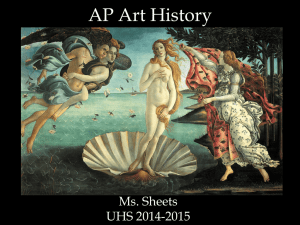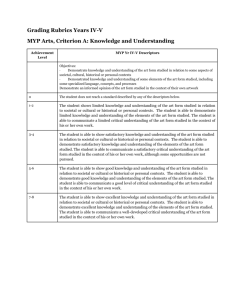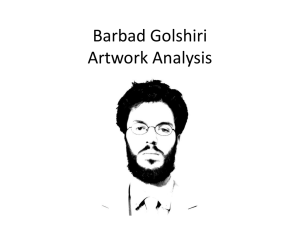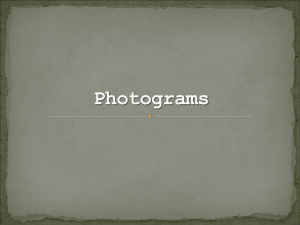MYP Arts Assessment Criteria
advertisement
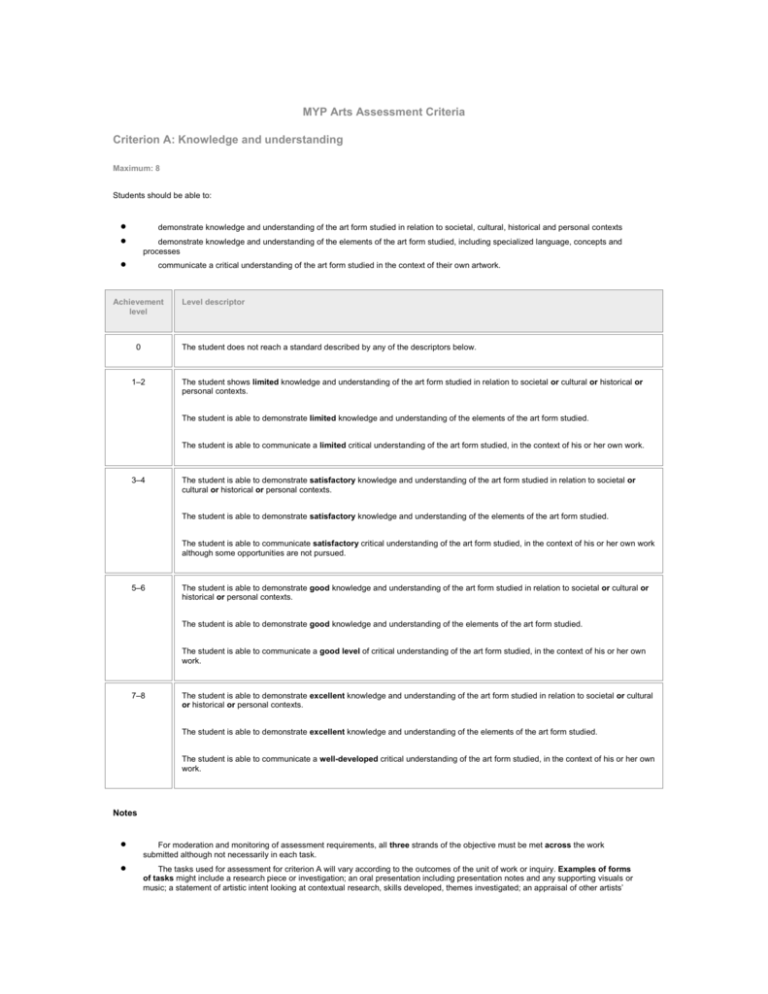
MYP Arts Assessment Criteria Criterion A: Knowledge and understanding Maximum: 8 Students should be able to: demonstrate knowledge and understanding of the art form studied in relation to societal, cultural, historical and personal contexts demonstrate knowledge and understanding of the elements of the art form studied, including specialized language, concepts and processes communicate a critical understanding of the art form studied in the context of their own artwork. Achievement level 0 Level descriptor The student does not reach a standard described by any of the descriptors below. 1–2 The student shows limited knowledge and understanding of the art form studied in relation to societal or cultural or historical or personal contexts. The student is able to demonstrate limited knowledge and understanding of the elements of the art form studied. The student is able to communicate a limited critical understanding of the art form studied, in the context of his or her own work. 3–4 The student is able to demonstrate satisfactory knowledge and understanding of the art form studied in relation to societal or cultural or historical or personal contexts. The student is able to demonstrate satisfactory knowledge and understanding of the elements of the art form studied. The student is able to communicate satisfactory critical understanding of the art form studied, in the context of his or her own work although some opportunities are not pursued. 5–6 The student is able to demonstrate good knowledge and understanding of the art form studied in relation to societal or cultural or historical or personal contexts. The student is able to demonstrate good knowledge and understanding of the elements of the art form studied. The student is able to communicate a good level of critical understanding of the art form studied, in the context of his or her own work. 7–8 The student is able to demonstrate excellent knowledge and understanding of the art form studied in relation to societal or cultural or historical or personal contexts. The student is able to demonstrate excellent knowledge and understanding of the elements of the art form studied. The student is able to communicate a well-developed critical understanding of the art form studied, in the context of his or her own work. Notes For moderation and monitoring of assessment requirements, all three strands of the objective must be met across the work submitted although not necessarily in each task. The tasks used for assessment for criterion A will vary according to the outcomes of the unit of work or inquiry. Examples of forms of tasks might include a research piece or investigation; an oral presentation including presentation notes and any supporting visuals or music; a statement of artistic intent looking at contextual research, skills developed, themes investigated; an appraisal of other artists’ work; a comparison or analysis of art practices in the context of the themes being investigated; a test that includes extended writing and so on. This assessment criterion needs to be clarified for students according to the outcomes for the unit of work or task, providing them with details of what they need to show or attain at different levels for tasks assessed using criterion A. It is important that these details are also included in the background information folder for moderation or monitoring samples of assessed work. Criterion B: Application Maximum: 10 Students should be able to: develop an idea, a theme or a personal interpretation to a point of realization, expressing and communicating their artistic intentions apply skills, techniques and processes to create, perform and/or present art. Achievement level 0 Level descriptor The student does not reach a standard described by any of the descriptors below. 1–2 There is very limited expression and communication of artistic intentions in the student’s work, which may not have reached a point of realization. Skills and techniques are applied at a very limited level of proficiency. The student attempts to apply the artistic processes. 3–4 There is limited expression and communication of artistic intentions in the student’s work, which has reached a point or partial point of realization. Skills and techniques are applied at a limited level of proficiency. The student attempts to apply the artistic processes. 5–6 The student is able to elaborate an idea, a theme or a personal interpretation to a point of realization. There is satisfactory expression and communication of artistic intentions. Skills and techniques are applied at a satisfactory level of proficiency. The student shows a satisfactory ability to apply the artistic processes involved in creating art. 7–8 The student is able to elaborate an idea, a theme or a personal interpretation to a point of realization. There is evidence of good expression and communication of artistic intentions. Skills and techniques are applied at a good level of proficiency. The student shows a good ability to apply the artistic processes involved in creating art. 9–10 The student is able to elaborate an idea, a theme or a personal interpretation to a point of realization. There is evidence of purposeful expression and effective communication of artistic intentions. Skills and techniques are applied at a high level of proficiency. The student shows an excellent ability to apply the artistic processes involved in creating art. Notes For moderation and monitoring of assessment requirements, both strands must be met in each task submitted. Evidence of process work for criterion B will include extracts from the developmental workbook showing work from the beginning of the process to a certain point of realization, and materials and artifacts that relate to the work such as diagrams, photos, texts, visual influences. Reflection and evaluation assessed using criterion C will link directly to work produced in relation to criterion B and should be placed together in the student’s folder. This assessment criterion needs to be clarified for students according to the outcomes for the unit of work or task, providing them with details of what they need to show or attain at different levels for tasks assessed using criterion B. It is important that these details are also included in the background information folder for moderation or monitoring samples of assessed work. Criterion C: Reflection and evaluation Maximum: 8 Students should be able to: reflect critically on their own artistic development and processes at different stages of their work evaluate their work use feedback to inform their own artistic development and processes. Achievement level 0 Level descriptor The student does not reach a standard described by any of the descriptors below. 1–2 The student records his or her artistic development and processes with little reflection. The student carries out a limited evaluation of his or her work, with guidance. 3–4 The student reflects on his or her artistic development and processes. The student carries out a satisfactory evaluation of his or her work. Some aspects of the evaluation may be unrealistic or incomplete. The student attempts to use feedback in his or her artistic development and processes, with guidance. 5–6 The student reflects critically on his or her artistic development and processes at different stages of his or her work. The student carries out a good evaluation of his or her work. The evaluation includes an appraisal of the quality of work produced and an identification of some areas of improvement. The student uses feedback in his or her artistic development with little guidance, which informs his or her own artistic development and processes. 7–8 The student reflects critically and in depth on his or her artistic development and processes at different stages of his or her work. The student carries out an excellent evaluation of his or her work. This shows a considered appraisal of the quality of work produced and details of improvements that could be made. The student intentionally uses feedback in his or her artistic development, which shows an appropriate consideration of his or her artistic processes. Notes For moderation and monitoring of assessment requirements, all three strands must be met in each task submitted. The purpose of this criterion is to focus students’ attention on their own creative work and their development in the art form. Students need to be guided in their evaluation of their strengths and weaknesses and their development in the subject. This includes their analysis of the process of working, discussion of themes and issues raised by the work, and responses to feedback from the teacher and from other students. Reflection and evaluation should be an ongoing process in MYP arts, so feedback and responses to it, as well as self-appraisal, need to be recorded in the developmental workbook. When compiling samples for moderation or monitoring of assessment, teachers are asked to include examples of both ongoing and retrospective reflection and evaluation for criterion C. Reflections on, appraisals and critiques of the work of other artists should be assessed using criterion A. Criterion D: Personal engagement Maximum: 8 Students should be able to: show commitment in using their own artistic processes demonstrate curiosity, self-motivation, initiative and a willingness to take informed risks support, encourage and work with their peers in a positive way be receptive to art practices and artworks from various cultures, including their own. Achievement level Level descriptor 0 The student does not reach a standard described by any of the descriptors below. 1–2 The student shows limited commitment in using his or her own artistic processes. The student demonstrates limited curiosity, self-motivation, initiative and a willingness to take informed risks. The student works with his or her peers in a positive way, with encouragement. The student is rarely receptive to art practices and artworks from various cultures, including his or her own. 3–4 The student shows satisfactory commitment in using his or her own artistic processes. The student demonstrates satisfactory curiosity, self-motivation, initiative and a willingness to take informed risks. The student supports, encourages and works with his or her peers in a positive way, with encouragement. The student is occasionally receptive to art practices and artworks from various cultures, including his or her own. 5–6 The student shows good commitment in using his or her own artistic processes. The student generally demonstrates curiosity, self-motivation, initiative and a willingness to take informed risks. The student supports, encourages and works with his or her peers in a positive way, with little encouragement. The student is generally receptive to art practices and artworks from various cultures, including his or her own. 7–8 The student shows excellent commitment in using his or her own artistic processes. The student actively demonstrates curiosity, self-motivation, initiative and a willingness to take informed risks. The student actively supports, encourages and works with his or her peers in a positive way. The student is actively receptive to art practices and artworks from various cultures, including his or her own. Notes For moderation and monitoring of assessment requirements, the level provided should relate to the work submitted in the sample and teacher comments should be included in each student’s folder. The comments should highlight the specific strands that have been met during the completion of the work.
